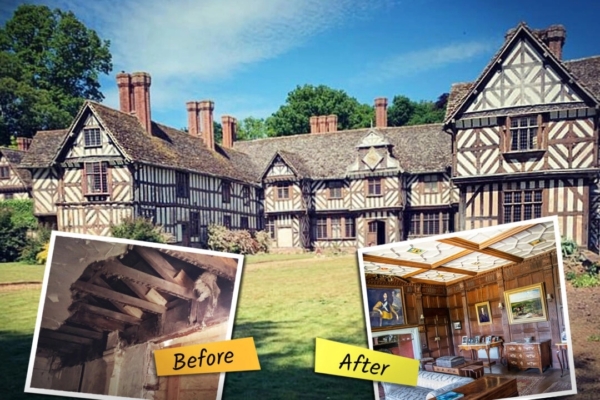Stretching back to a home built some nine years before the reign of Queen Elizabeth I of England, Pitchford Hall stands as a testament to centuries of epic family history, passed down through generations without ever being sold. The childhood residence of Rowena Nason, wife of James Nason, the house has a history that dates back 500 years, older than even the birth of renowned writer William Shakespeare.
The manor witnessed its fair share of events over the centuries, with the Ottleys, an important wool merchant family from Shropshire, initially purchasing the land in 1473. Pitchford Hall was constructed using the family’s wealth to host significant figures, including royalty who may have spent the night there.
The structure itself, with its half-timbered black-and-white façade, is a striking sight. Dark British oak panels beautifully contrast with the pure white lime wash on the sides, creating a visually appealing architectural marvel.
Pitchford Hall boasts approximately 60 rooms, serving as a gem of the estate. A massive fireplace once provided warmth to the family during winter, while other rooms included living areas, kitchens, pantries, a game room, a library, numerous bedrooms, and wings for the staff.
The illustrious history of the manor continued to evolve, passing through different families over the years, hosting notable guests like Queen Victoria and potentially even Prince Rupert. During World War II, the estate played a role in a royal escape plan known as the “Coats Mission,” offering refuge to the monarch in case of a Nazi invasion of Britain.
Each generation brought new items and furnishings to the house, adding to its charm with historical artifacts and antiques. Eventually, the property was inherited by Rowena Nason’s mother from her stepfather, Robin Grant, in 1972, marking the continuation of the family’s epic saga.
Upon the house being sold to a Kuwaiti princess following bankruptcy, the neglected manor began to deteriorate rapidly. With the new owner seldom spending any time there, the once-majestic abode started to crumble, gradually falling into disrepair over the years.
For Rowena and James Nason, the sentimental value of Pitchford Hall was immeasurable. The couple, who bought back the estate two decades ago, commenced the arduous task of restoring the mansion to its former glory.
The journey to reclaim their family’s legacy was not without challenges. After reaching a deal with the princess’s agent in 2016, the Nasons needed to purchase the manor within three months for £2 million or risk it being sold on the open market. They secured a bank loan, invested in insurance for the property, and completed the transaction in September 2016.
Stepping into the once-familiar halls of Pitchford Hall was both a moment of triumph and nostalgia for Rowena Nason. Despite the emotional impact of seeing the dilapidated condition of her childhood home, the couple remained steadfast in their resolve to bring the manor and estate back to life.
The renovation efforts have been extensive, involving the restoration of various sections of the property, including the west wing transformed into a holiday rental unit. Additionally, guided tours have been offered to generate funds for the ongoing repairs, all while balancing the demands of their professional lives.
Rowena Nason, who works at a British private equity firm, and her husband, a political adviser to the UK government, have taken on a new role in their journey since 2016 – that of restoring Pitchford Hall.
Navigating through dusty corridors, fallen plaster, debris, deceased insects, and bats has been a daunting task. Despite the challenges, the couple has managed to preserve pieces of history within the manor, with treasures like a watercolor painting once owned by Lord Liverpool being returned to them.
As they continue their efforts to breathe new life into the centuries-old residence, the Nasons have also found ways to generate income through events, weddings, and rentals. To date, they have poured approximately £1.5 million into the restoration.
Reflecting on their work, the couple asks themselves a simple question – would Rowena Nason’s mother recognize the place where she spent her childhood? For the Nasons, revitalizing Pitchford Hall goes beyond personal satisfaction, becoming a shared responsibility to preserve a part of England’s heritage that transcends boundaries of family and nationality.

